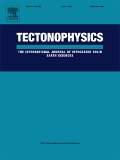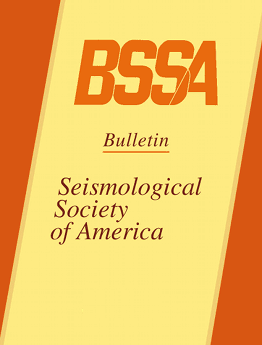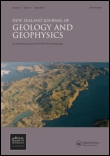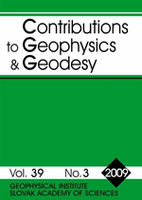
TECTONOPHYSICS
Scope & Guideline
Advancing Earth Science through Innovative Research
Introduction
Aims and Scopes
- Tectonic Processes and Mechanisms:
Research on the underlying processes that govern tectonic movements, including faulting, seismic activity, and the role of fluids in tectonic settings. - Seismicity and Earthquake Mechanics:
Studies investigating the mechanics of earthquakes, including rupture processes, seismic wave propagation, and the relationship between seismicity and tectonic features. - Geophysical Imaging and Modeling:
Utilization of advanced geophysical techniques such as seismic tomography, magnetotellurics, and geodetic measurements to image subsurface structures and understand tectonic evolution. - Mantle Dynamics and Lithospheric Studies:
Research on the behavior of the Earth's mantle and lithosphere, including studies of anisotropy, rheology, and the thermal structure of tectonic plates. - Tectonic Evolution and Geodynamics:
Exploration of the historical and ongoing tectonic processes that shape the Earth's surface, with an emphasis on regional studies and their implications for global tectonics.
Trending and Emerging
- Induced Seismicity and Anthropogenic Impacts:
There is a notable increase in studies examining the relationship between human activities, such as fluid injection and geothermal energy extraction, and induced seismic events. - Machine Learning in Seismic Analysis:
The application of machine learning techniques for seismic event detection, analysis, and forecasting is gaining traction, showcasing the integration of computational methods with traditional seismology. - Interdisciplinary Approaches to Tectonics:
Research that combines geological, geophysical, and geochemical methods to address complex tectonic questions is on the rise, reflecting a shift towards more holistic studies of tectonic phenomena. - Impact of Climate Change on Tectonics:
Emerging studies are increasingly focusing on how climate change and glacial movements influence tectonic processes, highlighting the interconnectedness of Earth's systems. - High-Resolution Geophysical Imaging:
Advancements in imaging techniques, such as high-resolution seismic tomography and ambient noise methods, are becoming more prevalent, enabling more detailed studies of tectonic structures.
Declining or Waning
- Traditional Geomorphology Studies:
Research focused solely on geomorphological features and processes has seen a decline, as there is a growing trend towards integrating geomorphology with tectonic processes and geophysical data. - Basic Seismology without Tectonic Context:
Papers that solely address seismic events without linking them to broader tectonic frameworks are becoming less common, as there is a stronger emphasis on understanding seismicity in relation to tectonic movements. - Local Case Studies without Global Implications:
Research that focuses exclusively on localized case studies without discussing their implications for broader tectonic theories or global patterns is less frequently published, as the journal increasingly prioritizes work that connects local findings to global tectonic processes.
Similar Journals

GEOTECTONICS
Charting New Territories in Tectonic Research.GEOTECTONICS is a distinguished academic journal published by PLEIADES PUBLISHING INC, focusing on key developments in the field of geology. Established in 1978, the journal has dedicated itself to exploring the intricate processes and phenomena associated with Earth's tectonic systems, making substantial contributions to Earth and Planetary Sciences. With an impressive impact factor reflected in its Q2 ranking within the Scopus category of Geology, GEOTECTONICS stands out as a valuable resource for researchers, professionals, and students alike. The journal offers a platform for rigorous peer-reviewed research that spans both fundamental theories and practical applications in geosciences, affirming its significance in fostering academic discourse and advancing geological knowledge. Although it currently does not offer open access, the journal's accessible format and continued publication through to 2024 ensures that it remains at the forefront of geoscientific inquiry.

JOURNAL OF GEOPHYSICAL RESEARCH-SOLID EARTH
Fostering Innovation in Geochemistry and PetrologyJOURNAL OF GEOPHYSICAL RESEARCH-SOLID EARTH is a prestigious journal published by the American Geophysical Union, dedicated to advancing the study of solid Earth sciences. With an ISSN of 2169-9313 and E-ISSN of 2169-9356, it serves as a leading platform for rigorous research findings and innovative advancements within the fields of Earth and Planetary Sciences, Geochemistry and Petrology, Geophysics, and Space and Planetary Science. The journal has achieved an impressive Q1 quartile ranking across these categories, reflecting its high impact in the academic community and underscoring its role in influencing scientific discourse. Notably, it holds an esteemed position in Scopus, ranking 15th among 159 journals in Earth and Planetary Sciences (miscellaneous) as well as within the top 20 in several other geophysical domains. Researchers and practitioners are encouraged to contribute their work to this esteemed journal, which publishes comprehensive articles from 1979 to the present, thus providing a crucial repository of knowledge for those engaged in solid Earth research. Although it does not currently offer Open Access options, the journal's prestigious reputation ensures its articles reach a wide audience of academics, professionals, and students alike, fueling a deeper understanding of our planet's processes and challenges.

Geodesy and Geodynamics
Pioneering Insights into Earth's Structure and Dynamics.Geodesy and Geodynamics is a premier open-access journal dedicated to the interdisciplinary fields of geodesy and geodynamics, published by KEAI PUBLISHING LTD. With a commitment to accessibility since 2010, this journal serves as an essential platform for researchers, professionals, and students in understanding the Earth's structure, dynamics, and geophysical processes. Based in China, it has rapidly gained recognition, earning a commendable Q2 ranking in various categories, including Computers in Earth Sciences, Earth-Surface Processes, and Geophysics. The journal covers critical advances in theory and practice, making significant contributions to the study of planetary sciences. Researchers can benefit from a robust readership and impactful dissemination of their work, as evidenced by its solid positions in Scopus rankings. Moving forward, Geodesy and Geodynamics aims to continue fostering innovation and collaboration within the geoscience community through high-quality research and comprehensive review articles.

Earthquake Science
Pioneering Knowledge in Earthquake DynamicsEarthquake Science is a prominent open access journal that has been serving the scientific community since its inception in 2009, published by KEAI PUBLISHING LTD. With an ISSN of 1674-4519 and an E-ISSN of 1867-8777, this journal has established itself as a significant platform for the dissemination of research in the fields of geology, geophysics, and geotechnical engineering, evident from its Q2 ranking in 2023 across these categories. Based in China, Earthquake Science aims to facilitate knowledge sharing and foster interdisciplinary collaboration by publishing a range of high-quality articles, reviews, and research papers demonstrating advancements in understanding seismic activity and its impacts. Its commitment to open access since 2015 ensures that valuable insights are available to researchers, professionals, and students globally, thereby supporting critical inquiries into earthquake mechanisms and risk management strategies. Explore the latest findings and contribute to the ongoing conversation in the evolving landscape of earthquake science.

BULLETIN OF THE SEISMOLOGICAL SOCIETY OF AMERICA
Delivering cutting-edge insights into seismic phenomena.BULLETIN OF THE SEISMOLOGICAL SOCIETY OF AMERICA is a premier journal published by the Seismological Society of America, dedicated to advancing research in the field of seismology and related disciplines. Since its inception in 1969, this journal has garnered significant recognition, evidenced by its impressive Q1 category rankings in both Geochemistry and Petrology, and Geophysics, alongside a solid standing within the Earth and Planetary Sciences Scopus rankings. The journal is esteemed for publishing high-quality, peer-reviewed articles that contribute to the understanding of seismic activities and their implications on a global scale. With a commitment to facilitating the dissemination of critical findings, it serves as an essential resource for researchers, professionals, and students alike who are engaged in the dynamic and vital study of the Earth’s processes. While the journal is not Open Access, it continues to provide vital insights and methodologies that shape the future of geophysical research.

Geodynamics & Tectonophysics
Elevating the Study of Earth-Surface ProcessesGeodynamics & Tectonophysics, published by the esteemed Russian Academy of Sciences, Siberian Branch, Inst Earths Crust, is a pivotal open-access journal that has been contributing to the scientific discourse on Earth's dynamic processes since 2010. With an ISSN of 2078-502X, this journal serves as a vital platform for researchers and professionals interested in the fields of Earth-Surface Processes, Economic Geology, Geology, and Geophysics, holding a Q3 ranking in each of these categories as of 2023. The journal is based in Irkutsk, Russia, and encompasses a broad spectrum of topics, fostering interdisciplinary collaboration and innovation. Researchers can access cutting-edge studies and insights, engaging with a community committed to advancing our understanding of geodynamics and tectonic phenomena. With a sustained commitment to quality and accessibility, Geodynamics & Tectonophysics plays a critical role in addressing pressing geological concerns and advancing global geological research.

GEOSCIENCES JOURNAL
Advancing Knowledge in Earth and Planetary Sciences.Welcome to the GEOSCIENCES JOURNAL, a pivotal publication in the fields of Earth and Planetary Sciences and Environmental Science, proudly presented by the Geological Society of Korea. Established in 1997, this journal has become a prominent platform for researchers, professionals, and students, offering a rich collection of peer-reviewed articles that explore a diverse array of geoscientific topics. With an impressive Q2 ranking in both Earth and Planetary Sciences and Environmental Science categories for 2023, it stands as an essential resource in the academic community. Though it operates under a traditional subscription model, GEOSCIENCES JOURNAL remains dedicated to advancing knowledge through rigorous research. Addressed from its headquarters in Seoul, South Korea, the journal aims to foster a deeper understanding of geosciences, encouraging innovation and collaboration in tackling today’s environmental challenges.

NEW ZEALAND JOURNAL OF GEOLOGY AND GEOPHYSICS
Unveiling the Earth's Secrets Through Rigorous Research.NEW ZEALAND JOURNAL OF GEOLOGY AND GEOPHYSICS, published by Taylor & Francis Ltd, stands as a prominent forum dedicated to the interdisciplinary exploration of geological and geophysical phenomena. With an impact factor that situates this journal in the prestigious Q1 category across key subjects—namely Earth and Planetary Sciences, Geology, and Geophysics—it is a critical resource for researchers, professionals, and students alike. The journal has been operational since 1958 and continues to contribute valuable insights into the complexities of the Earth's processes. Although it does not currently offer Open Access options, its broad readership benefits from an extensive archive of high-quality research findings that span from 1958 to 2024. Located in the United Kingdom, the journal remains a pivotal player in advancing the understanding of Earth's systems, making significant contributions to both academic inquiry and practical applications in the field.

Contributions to Geophysics and Geodesy
Bridging Knowledge Gaps in Earth Science ResearchContributions to Geophysics and Geodesy is a distinguished open access journal dedicated to advancing the field of geophysics and geodesy, published by the SLOVAK ACADEMY OF SCIENCES, EARTH SCIENCE INSTITUTE. With a rich publication history since its inception in 1992 and a commitment to open access since 2009, this journal serves as a vital platform for disseminating innovative research and critical insights in Earth sciences. Although it currently holds a Q4 ranking in the Geophysics category and is positioned in the 29th percentile, it continues to foster scholarly dialogue and enhance the visibility of significant findings in the community. Situated in Slovakia, the journal's address underscores its international reach and relevance. Researchers, professionals, and students alike will find valuable resources and perspectives within its pages, aiming to bridge gaps in knowledge and contribute meaningfully to the ongoing global discourse in geophysical sciences.

TECTONICS
Unveiling the Secrets of Earth's Structure and ProcessesTECTONICS, published by the American Geophysical Union, is a prestigious journal that serves as a critical platform for research in the fields of geochemistry, petrology, and geophysics. With an impressive Q1 ranking in both Geochemistry and Petrology and Geophysics for 2023, and a Scopus rank placing it in the top tiers of Earth and Planetary Sciences, this journal highlights significant advancements and emerging trends relevant to earth sciences. Operating from the United States, TECTONICS covers an extensive range of topics from structural geology to plate tectonics, providing an essential resource for researchers, professionals, and students aiming to deepen their understanding of earth dynamics and processes. Although it does not offer open access, the journal's rigorous peer-review process ensures the dissemination of high-quality research. With a commitment to advancing the scientific discourse surrounding tectonic processes, TECTONICS plays a vital role in shaping the future of geosciences.